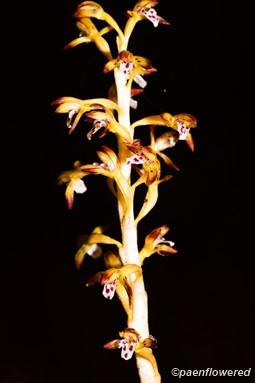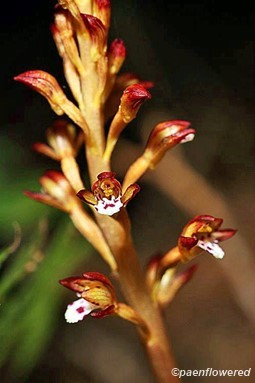Corallorhiza maculata
Corallorhiza maculata spotted coralroot
This species is another perennial member of the orchid family that lack green pigment and bear their flowers on a leafless stalk. The spotted coralroot is the largest member of the genus, growing 8-20 inches tall. The flowers are tawny yellow aging to dull purple or purple-brown. Ten to thirty flowers bloom along a yellowish or brownish stalk. Leaves are reduced to tubular sheaths about 3 inches long. Each flower is about 0.75 in long. The lip petal is white, squarish in shape and spotted in bright red. There are three short sepals on top that resemble petals and two long upper petals that surround the upper part of the lip. There is no nectar spur.
It blooms between July and September. For that reason it is sometimes called the summer orchid. It normally grows in moist to dry forests--both deciduous and coniferous. It can be found throughout North America except for some southern states. It is historically documented in most of the counties of Western Pennsylvania with the exception of Washington and Greene. This species obtains its nourishment not through photosynthesis but by a symbiotic relationship with soil fungi that grow on tree roots (Mycoheterotrophic). Thus it indirectly obtains its food from the trees. The underground stem is coral-like in appearance.
Habitat & Range
Frequent in dry, deciduous or coniferous forests.
Present throughout the state.
| EMP: | FACU |
|---|---|
| NCNE: | FACU |
Phenology
Flowers late June to September.
Plant Codes
S-rank: No rank
G-rank: G5 (Secure)





Comments
Have you spotted this plant in your area? We'd love to hear about your experience! Share your comments or questions about the plant below. Comments are moderated before posting.